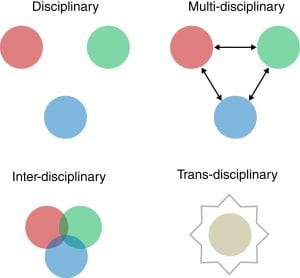As a species, we are facing several major challenges in the 21st century such as climate change, ecological degradation, poverty, and technological disruption. Addressing these challenges with meaningful solutions requires us to go beyond disciplinary boundaries.
Instead of trying to solve problems within individual disciplines, experts from different fields need to work together in interdisciplinary teams. Consequently, there is an increasing interest in conducting interdisciplinary research, which is leading to research on interdisciplinarity itself.

Overview of multi‐, inter‐, and transdisciplinary research strategies.
An important first step toward conducting interdisciplinary research is establishing a common understanding between experts from different fields about the various fields within the group. It can be argued that as interdisciplinary teams spend more time working together, the interdisciplinary understanding will increase.
An important question here is: Can this interdisciplinary understanding be tracked within a group? Furthermore, is it possible to quantify the level of disciplinary difference between the fields/projects within a group?
A study carried out at Boysen-TU-Dresden Graduate College (Boysen-TU-Dresden-Graduiertenkolleg) explores these questions. This WIREs Energy and Environment review proposes a framework that measures interdisciplinary understanding in a research group.
The key to the framework is defining dimensions that capture the differentiating “features” between the disciplines or projects. The definition of the dimensions also depends on the composition and the requirements within the group. This operational framework can be applied by interdisciplinary research groups or groups working in an interdisciplinary environment to increase the group’s cohesion.
The authors plan to expand and test the framework through its application in different groups. Hence, you are encouraged to get in contact if you are interested in applying the framework to your group for promoting interdisciplinary understanding.

















